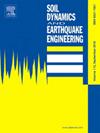不同轴向荷载作用下预制UHPC空心墩抗震性能试验研究及易损性分析
IF 4.2
2区 工程技术
Q1 ENGINEERING, GEOLOGICAL
引用次数: 0
摘要
预制桥墩在快速施工、质量控制和减少交通干扰方面具有吸引力。然而,传统的预制桥墩以实心截面为特征。如果设计成空心截面,不仅能减轻自重,方便运输和吊装,还能降低成本。同时,薄壁墩轴材料可考虑采用超高性能混凝土(UHPC),在不影响结构性能和安全性的前提下提高承载能力。虽然对加装 UHPC 护套或使用 UHPC 连接的墩柱进行了一些研究,但对预制 UHPC 空心墩的研究还很有限,尤其是关于其对不同轴向荷载的结构响应。在本研究中,通过准静态试验研究了三个 UHPC 空心桥墩在不同轴向荷载作用下的滞回行为,同时还研究了一个普通混凝土(NC)空心桥墩和一个 NC 实心桥墩的对比情况。研究指标包括破坏模式、能量耗散、刚度退化、残余位移、挤压效应和曲率分布。然后,在 OpenSees 中建立了一个细化的有限元(FE)模型,将粘结滑移的影响和连接界面的循环行为纳入其中。最后,利用近断层和远断层地动对五个测试桥墩进行了脆性分析。结果表明,轴向荷载增加会导致峰值荷载增大,但延展性、极限位移和残余位移会减小,同时会产生更明显的挤压效应。脆性分析结果表明,与数控实心/空心桥墩相比,超高性能混凝土空心桥墩的损坏概率较低。然而,随着 UHPC 桥墩轴向荷载的增加,损坏概率也随之增加。本文章由计算机程序翻译,如有差异,请以英文原文为准。
Experimental investigation and fragility analysis on seismic performance of precast UHPC hollow piers under varying axial load
Precast bridge piers are attractive in the context of rapid construction, quality control, and reduced traffic disturbances. Nevertheless, conventional precast piers are featured by solid sections. If designed with hollow sections, it would not only reduce self-weight, facilitating transportation and lifting, but also lower costs. Meanwhile, ultra-high-performance concrete (UHPC) can be considered for the thin-walled pier shaft material to enhance bearing capacity without compromising its structural performance and safety. Although some studies have been carried out on the pier columns retrofitted with UHPC jacket or using UHPC connections, there has been limited research on precast UHPC hollow piers, particularly concerning their structural response to varying axial loads. In this study, the hysteretic behavior of three UHPC hollow bridge piers under varying axial load was investigated by quasi-static tests, along with one normal concrete (NC) hollow pier and one NC solid pier for comparison. The interested indicators include failure mode, energy dissipation, stiffness degradation, residual displacement, pinching effect, and curvature distribution. Then, a refined finite element (FE) model was established in OpenSees, incorporating the effects of bond-slip and the cyclic behavior of the joint interface. Finally, fragility analyses on five tested piers were conducted with both near-fault and far-fault ground motions. The results demonstrated that increased axial load resulted in a higher peak load but reduced ductility, ultimate displacement, and residual displacement, along with a more significant pinching effect. The fragility analysis results indicated that UHPC hollow piers exhibited lower damage probability compared to NC solid/hollow piers. However, as the axial load on the UHPC piers increased, the damage probability also increased.
求助全文
通过发布文献求助,成功后即可免费获取论文全文。
去求助
来源期刊

Soil Dynamics and Earthquake Engineering
工程技术-地球科学综合
CiteScore
7.50
自引率
15.00%
发文量
446
审稿时长
8 months
期刊介绍:
The journal aims to encourage and enhance the role of mechanics and other disciplines as they relate to earthquake engineering by providing opportunities for the publication of the work of applied mathematicians, engineers and other applied scientists involved in solving problems closely related to the field of earthquake engineering and geotechnical earthquake engineering.
Emphasis is placed on new concepts and techniques, but case histories will also be published if they enhance the presentation and understanding of new technical concepts.
 求助内容:
求助内容: 应助结果提醒方式:
应助结果提醒方式:


